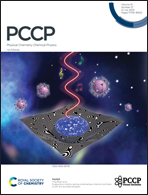The effect of histidine behaviors on the structural properties of Aβ(1–42) peptide in protonation stage one, two, and three†
Abstract
Histidine behaviors (including tautomeric and protonation behaviors, and integration on ε, δ, or p states) have been linked to protein folding and misfolding. However, the histidine behaviors of Aβ(1–42) are unconfirmed, which is the key point to understanding the pathogenesis of Alzheimer's disease. In the current study, 19 replica exchange molecular dynamics (REMD) simulations were performed to investigate the impact of histidine on the structural properties in protonation evolution stages one, two, and three. In contrast to the deprotonated (εεε) state, our current findings demonstrate that any protonated state will promote the formation of the β-sheet structure. The sheet-rich structures of (pεε), (δεp), (pεp), and (ppp) have the same basic characteristics of three-strand structures between the N-terminus, central hydrophobic core (CHC), and C-terminus. We found that the (pεε) (probability of 77.7%) and (δεp) (probability of 60.2%) prefer the abundant conformation over the other systems with higher regularity antiparallel β-sheet structure characteristics. Further H-bonding results indicate that H6 and H14 are more essential than H13. In addition, the Pearson correlation coefficient analysis revealed that the experimental result coincided with our simulated (δpε) system. The current study aids in the better understanding of the mechanisms of histidine behaviors, providing a fresh outlook on protein folding and misfolding.



 Please wait while we load your content...
Please wait while we load your content...